The Dalai Lama's recent second visit to Taiwan has brought a long-hidden issue to light in Taiwan, namely the potential for Tibetan Buddhism and other forms of Buddhism to take root in society. To what degree these religions can become a part of local culture will likely be determined, in economic terms, according to demand, which by all estimations is large.
Using an analogy from economics may seem at first disrespectful, yet it reveals much historical truth about how different Buddhist groups have seen their "religious kingdoms" rise and decline over the past several decades. Borrowing more economic lingo, there is a glut in the current religion market, as major Buddhist groups compete to carry out their often grand expansion plans.
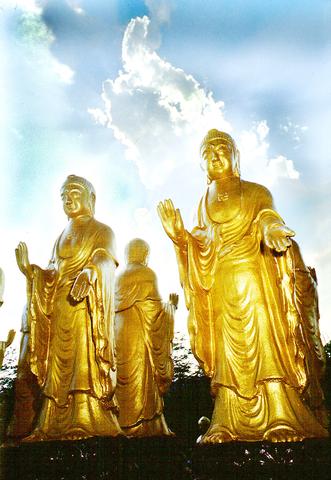
PHOTO: CHEN CHENG-CHANG, TAIPEI TIMES
The attempt of Tibetan Buddhism to squeeze into the already crowded local religious market in the near future is bound to cause friction among Buddhist groups.
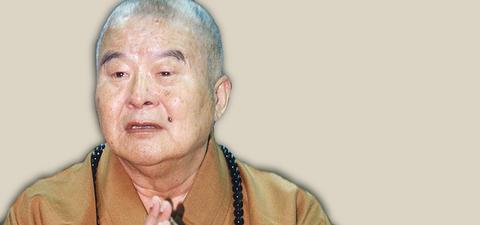
Interestingly, the escalation of Buddhist influence in Taiwan occurred in tandem with the island's economic take-off in the 1970s. Massive migration from the countryside to the cities in the late 1960s left many people alienated and in search of spiritual guidance.
Also at about this time, the influence of Christian churches began to wane in Taiwan, due mainly to diminishing material and personnel support from abroad. Indigenous religions, Buddhism in particular, then arose to fill the gap where the Christian churches had receded.
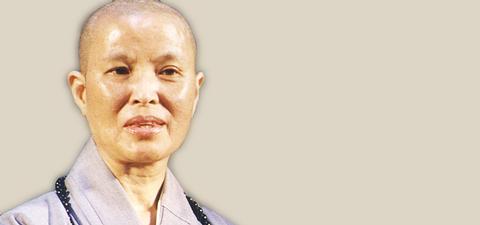
Amid rapid social, economic and political changes in the early 1970s, two renowned religious groups emerged from very humble beginnings to expand almost exponentially in influence and size. One is the Buddha Light religious group (佛光教團) based in Kaohsiung and the Buddhist Compassion Relief Tzu Chi Foundation (慈濟功德會) founded in Hualien. Two groups to emerge since 1987, after the lifting of martial law, were Dharma Drum Mountain religious group (法鼓教團) and the Chung Tai Chan Monastery (中台禪寺). These gained a foothold among urban residents and intellectuals with their calls for self-reflection through Chan (禪) meditation, or Zen.
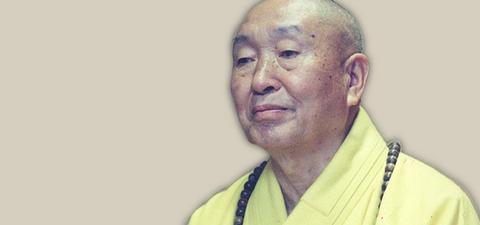
Buddha Light was founded by Master Hsing Yun (
He built a grand monastery on a hill overlooking Kaohsiung that served as a getaway of sorts for laborers during the weekends and on holidays. As the number of adherents grew, he started a TV program on Buddhist teachings in 1980 and quickly became famous.
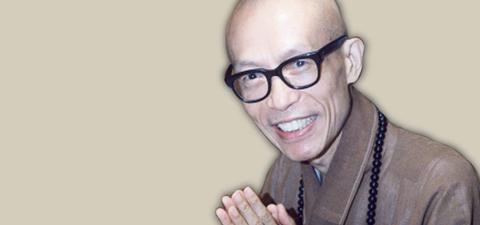
Master Hsing Yun is also gifted at corporate management and strategic planning, and so managed his Buddha Light Monastery (
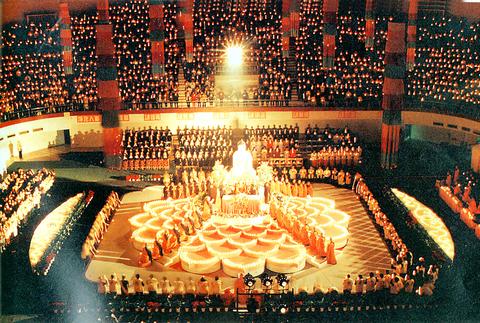
PHOTO COURTESY OF CHIAN CHANG-TENG
With its spacious grounds, shaded pathways decorated with various golden Buddha figures, and its stores and parking space, the monastery served as a one-stop shop for people in the 1960s looking to complete errands and seek spiritual enlightenment. Within a very short time, the monastery became a favorite tourist spot and has remained so for three decades. The Buddha Light religious group now claims more than one million followers around the world.
Master Hsing Yun branched out by setting up temples in other major cities in and outside of Taiwan. A recent estimate indicates that in addition to the Buddha Light Monastery headquarters, the group possesses at least five city or county-level temple groups called sub-headquarters (
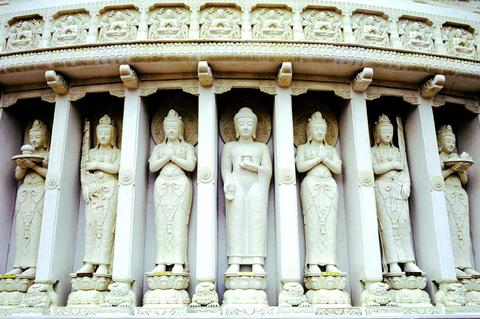
PHOTO: CHEN CHENG-CHANG, TAIPEI TIMES
The group has also purchased South-China Buddhist University (

PHOTO: CHEN CHENG-CHANG, TAIPEI TIMES
Soon after the rise of Buddha Light, a nun named Master Cheng Yen (
Professor Chiang Chang-teng (
Tzu-chi has expanded its scope from its original disaster victim relief to philanthropic activities, education, culture and hospital operation. The group runs four sub-headquarters in major cities and counties, with numerous divisions and offices in almost every town. In addition to hospitals in Hualien and Chiayi, the group is working to build two more hospitals in Hsintien, Taipei County and Neihu, Taipei City.
The Dharma Drum Mountain religious group (
In 1978, Master Wei Chueh (
As their number of followers increased, Master Wei Chueh decided to build Taiwan's largest Zen monastery in Puli, Nantou County The building is expected to be completed this year. Chung Tai, meanwhile, has grown from four disciples and 300 followers in 1987 to more than 1,000 disciples and over 100,000 followers and it also operates a Buddhist study institute.
Master Sheng Yen (
In October, 1996, after careful planning for three years, Master Sheng Yen announced the group's plan to build a Buddhist University (
All four groups have embarked on massive expansion projects. Given Taiwan's slumping economy, it remains to be seen whether these groups can see their plans to completion. Another hurdle will be the groups' transition to their next generation of leaders, as the current masters are quite advanced in years. The youngest, Master Cheng Yen, for example, is 65. The issue of succession within these groups is unresolved, but when changes come they will affect hundreds of thousands of followers.

June 2 to June 8 Taiwan’s woodcutters believe that if they see even one speck of red in their cooked rice, no matter how small, an accident is going to happen. Peng Chin-tian (彭錦田) swears that this has proven to be true at every stop during his decades-long career in the logging industry. Along with mining, timber harvesting was once considered the most dangerous profession in Taiwan. Not only were mishaps common during all stages of processing, it was difficult to transport the injured to get medical treatment. Many died during the arduous journey. Peng recounts some of his accidents in

“Why does Taiwan identity decline?”a group of researchers lead by University of Nevada political scientist Austin Wang (王宏恩) asked in a recent paper. After all, it is not difficult to explain the rise in Taiwanese identity after the early 1990s. But no model predicted its decline during the 2016-2018 period, they say. After testing various alternative explanations, Wang et al argue that the fall-off in Taiwanese identity during that period is related to voter hedging based on the performance of the Democratic Progressive Party (DPP). Since the DPP is perceived as the guardian of Taiwan identity, when it performs well,

A short walk beneath the dense Amazon canopy, the forest abruptly opens up. Fallen logs are rotting, the trees grow sparser and the temperature rises in places sunlight hits the ground. This is what 24 years of severe drought looks like in the world’s largest rainforest. But this patch of degraded forest, about the size of a soccer field, is a scientific experiment. Launched in 2000 by Brazilian and British scientists, Esecaflor — short for “Forest Drought Study Project” in Portuguese — set out to simulate a future in which the changing climate could deplete the Amazon of rainfall. It is

Artifacts found at archeological sites in France and Spain along the Bay of Biscay shoreline show that humans have been crafting tools from whale bones since more than 20,000 years ago, illustrating anew the resourcefulness of prehistoric people. The tools, primarily hunting implements such as projectile points, were fashioned from the bones of at least five species of large whales, the researchers said. Bones from sperm whales were the most abundant, followed by fin whales, gray whales, right or bowhead whales — two species indistinguishable with the analytical method used in the study — and blue whales. With seafaring capabilities by humans